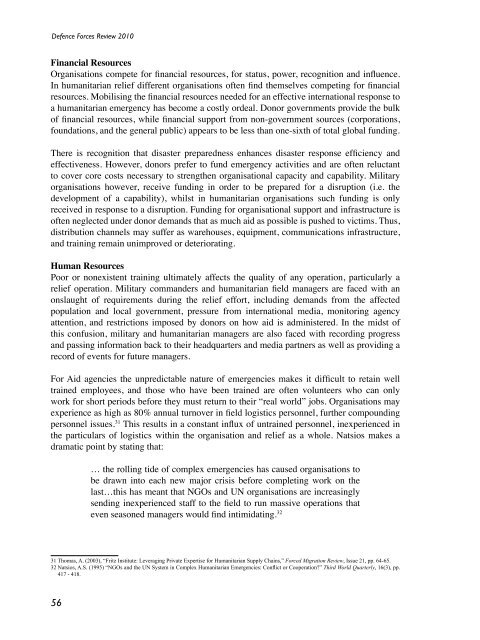Defence Forces Review 2010
Defence Forces Review 2010
Defence Forces Review 2010
You also want an ePaper? Increase the reach of your titles
YUMPU automatically turns print PDFs into web optimized ePapers that Google loves.
<strong>Defence</strong> <strong>Forces</strong> <strong>Review</strong> <strong>2010</strong>Financial ResourcesOrganisations compete for financial resources, for status, power, recognition and influence.In humanitarian relief different organisations often find themselves competing for financialresources. Mobilising the financial resources needed for an effective international response toa humanitarian emergency has become a costly ordeal. Donor governments provide the bulkof financial resources, while financial support from non-government sources (corporations,foundations, and the general public) appears to be less than one-sixth of total global funding.There is recognition that disaster preparedness enhances disaster response efficiency andeffectiveness. However, donors prefer to fund emergency activities and are often reluctantto cover core costs necessary to strengthen organisational capacity and capability. Militaryorganisations however, receive funding in order to be prepared for a disruption (i.e. thedevelopment of a capability), whilst in humanitarian organisations such funding is onlyreceived in response to a disruption. Funding for organisational support and infrastructure isoften neglected under donor demands that as much aid as possible is pushed to victims. Thus,distribution channels may suffer as warehouses, equipment, communications infrastructure,and training remain unimproved or deteriorating.Human ResourcesPoor or nonexistent training ultimately affects the quality of any operation, particularly arelief operation. Military commanders and humanitarian field managers are faced with anonslaught of requirements during the relief effort, including demands from the affectedpopulation and local government, pressure from international media, monitoring agencyattention, and restrictions imposed by donors on how aid is administered. In the midst ofthis confusion, military and humanitarian managers are also faced with recording progressand passing information back to their headquarters and media partners as well as providing arecord of events for future managers.For Aid agencies the unpredictable nature of emergencies makes it difficult to retain welltrained employees, and those who have been trained are often volunteers who can onlywork for short periods before they must return to their “real world” jobs. Organisations mayexperience as high as 80% annual turnover in field logistics personnel, further compoundingpersonnel issues. 31 This results in a constant influx of untrained personnel, inexperienced inthe particulars of logistics within the organisation and relief as a whole. Natsios makes adramatic point by stating that:… the rolling tide of complex emergencies has caused organisations tobe drawn into each new major crisis before completing work on thelast…this has meant that NGOs and UN organisations are increasinglysending inexperienced staff to the field to run massive operations thateven seasoned managers would find intimidating. 3231 Thomas, A. (2003), “Fritz Institute: Leveraging Private Expertise for Humanitarian Supply Chains,” Forced Migration <strong>Review</strong>, Issue 21, pp. 64-65.32 Natsios, A.S. (1995) “NGOs and the UN System in Complex Humanitarian Emergencies: Conflict or Cooperation?” Third World Quarterly, 16(3), pp.417 - 418.56
















